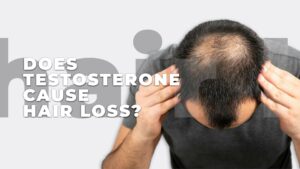As your delivery date approaches, you’re likely excited about the prospect of finally meeting your little one. However, there’s one thing that you may be apprehensive about losing – your thick and lustrous pregnancy hair. This is not a figment of your imagination; many women notice that their hair becomes thicker during pregnancy. Additionally, post pregnancy hair loss is not due to the stress of being a new mom. This article explains why your hair changes during pregnancy, what to expect after childbirth, and offer tips on how to manage it.
Contents
What Causes Postpartum Hair Loss?

The hormonal changes that occur during pregnancy and postpartum are significant. During pregnancy, there is a substantial increase in hormones. One of the first hormones to surge is human chorionic gonadotropin (hCG). It is the hormone detected by a pregnancy test to confirm pregnancy. Other hormones, such as estrogen, progesterone, oxytocin, and prolactin, also experience a rise in levels during pregnancy. Additionally, your blood volume increases, reaching as much as 50% greater volume than normal by your due date.
After giving birth, several hormone levels decline rapidly, including estrogen and progesterone. Within 24 hours of delivery, these hormones will return to nearly normal levels. However, prolactin levels remain high as long as you continue to breastfeed. After giving birth, estrogen levels decrease, causing a large number of hair strands to enter the resting phase of hair growth. This subsequently leads to hair shedding after a few months.
Although blood volume decreases, it does so gradually and returns to normal a few weeks after childbirth.
How Hormones Affect Your Hair?
The impact of hormones on your hair can be significant. The primary cause of changes in hair during pregnancy and postpartum hair loss is hormonal fluctuations.
While pregnant, elevated levels of estrogen prevent normal hair loss that occurs each day. Additionally, increased blood volume and circulation also decrease hair loss during pregnancy. However, once hormone levels drop after giving birth, hair loss accelerates. This results in the shedding of larger amounts of hair than usual. Although the total volume of hair loss over the last nine months may not have changed, it may seem more significant because it happens all at once.
Postpartum hair loss can occur at any time after childbirth, lasting up to a year. Typically, hair loss peaks around the four-month mark. Therefore, if you are still experiencing hair loss a few months after giving birth, it is not a cause for alarm.
When Does Postpartum Hair Loss Start?
The onset of postpartum hair loss can occur between two to four months after giving birth. The extent of hair loss varies among women and is not necessarily correlated with their hair’s quality or quantity during pregnancy. However, people with longer hair or lots of hair growth during pregnancy may think their hair loss is worse.
How Long Does Postpartum Hair Loss Last?

If you’re experiencing postpartum hair loss, don’t worry – it’s a natural process, and you’re not going bald. For breastfeeding mothers, some hair loss may continue until you begin to supplement with formula or solids or until you wean your baby.
Regardless of whether you breastfeed, it’s reassuring to know that your hair loss will stop by the time your baby celebrates their first birthday. Your hair should return to its pre-pregnancy state. So take comfort in the fact that you’ll soon have your luscious locks back!
What are Hair Tourniquets?
Hair tourniquets can occur when a strand of hair falls out and wraps around a baby’s toe, finger, or other body parts. It can become so tightly wrapped that it cuts off circulation or causes an infection.
Fortunately, hair tourniquets are rare, but new mothers should still be vigilant. If you notice a shed hair wrapped around your baby’s finger, toe, or another body part, you must remove it. Here’s what to do:
- Look for a loose end and gently unwind the hair.
- If you can’t find a loose end, use a small knife or scissors to cut the hair gently.
- If you cannot remove the hair because it is wound too tightly or enmeshed in your baby’s skin, seek medical assistance. Contact your baby’s doctor or go to the emergency room as soon as possible. In some cases, a doctor may need to remove a hair tourniquet.
Treatments for Postpartum Hair Loss

After giving birth, it is common for hair to become thinner. If this does not concern you, there is no need to treat it, and unfortunately, no method has been proven to prevent or slow down postpartum hair loss. However, if you are unhappy with your hair loss, there are some treatments that you can try to make your hair appear fuller and healthier:
- Avoid styling
Using a hair dryer or curling iron may make your hair appear thinner. Try to avoid elaborate styling and let your hair air-dry until the thinning subsides. Brushing too vigorously can also cause more hair to fall out, so be gentle when brushing and do not brush more than once a day. Use the extra time to bond with your baby or catch up on rest!
- Eat healthily
The best way to ensure that your body receives all the nutrients it needs is to include a variety of fruits, vegetables, and healthy proteins in your diet. Eating certain foods can help improve hair health. These include dark leafy greens (for iron and vitamin C), sweet potatoes and carrots (for beta carotene), eggs (for vitamin D), and fish (for omega-3s and magnesium).
- Medication for hair loss
Some women may find that over-the-counter minoxidil can help stimulate hair growth. Speak with a healthcare professional before starting any medication to ensure it is safe for you and your baby if you are breastfeeding.
- Take your vitamins
Vitamins should not be used as a substitute for a well-balanced diet, particularly when you are a new mother with a baby to care for. However, they may be beneficial as a supplement if your diet is deficient in nutrients. While no particular vitamins have been proven to help with hair loss, they are essential for overall health. It is advised that you continue taking your prenatal vitamins after giving birth, particularly if you are breastfeeding.
- Use volumizing shampoo
While there is no evidence to support it, conditioning shampoos may weigh down your hair and make it appear thinner and lifeless. Volumizing shampoos can add body to your hair and help you maintain a glossy appearance.
- Make use of hair accessories
Headbands, scarves, and bandannas are fun and fashionable ways to conceal postpartum hair loss. They’re especially popular among new parents who have limited time for hair care.
- Change your hair part
If you usually part your hair in the middle, try a side part to conceal thinning hair at the temples.
- Reduce stress levels
Lowering your stress levels not only promotes your well-being but also helps to balance hormone levels. Relaxation techniques such as mindfulness, meditation, or breathing exercises can help lower stress. Engage in gentle or moderate exercise regularly, as it may also help to relieve stress. Don’t hesitate to ask friends and loved ones for assistance in caring for the baby or with household tasks if you feel burdened.
Final Thoughts
Excessive hair shedding after pregnancy is common for new mothers, with shedding typically reaching its peak around four months postpartum. However, most women’s hair growth returns to normal by their child’s first birthday.
Seek assistance from a dermatologist if your hair does not recover its usual fullness after one year. It could be due to an underlying issue. There are many reasons why people lose hair, and a correct diagnosis is necessary for effective treatment.
References
- Hair Loss in New Moms. (2010, August 5)
aad.org/public/skin-hair-nails/hair-care/hair-loss-in-new-moms - Human Chorionic Gonadotropin (HCG): The Pregnancy Hormone. (2015, December)
americanpregnancy.org/while-pregnant/hcg-levels/ - Hughes EC, Saleh D. Telogen Effluvium. (https://www.statpearls.com/ArticleLibrary/viewarticle/29916) [Updated 2021 June 8].
- Murphrey MB, Agarwal S, Zito PM. Anatomy, Hair. (https://www.statpearls.com/ArticleLibrary/viewarticle/22481)
- Mayo Clinic Staff. (2014, July 11). Heart conditions and pregnancy: Know the risks
mayoclinic.org/healthy-lifestyle/pregnancy-week-by-week/in-depth/pregnancy/art-20045977 - Your body after baby: the first 6 weeks. (2012, July)
marchofdimes.org/pregnancy/your-body-after-baby-the-first-6-weeks.aspx#










Leave a reply